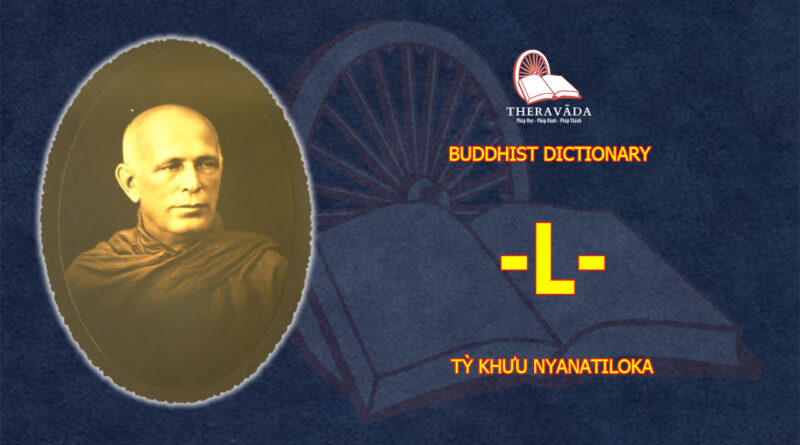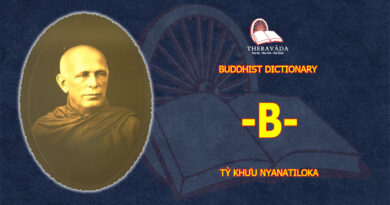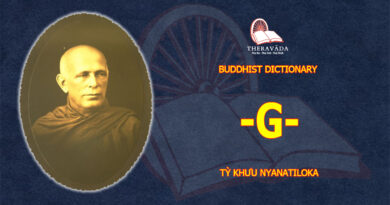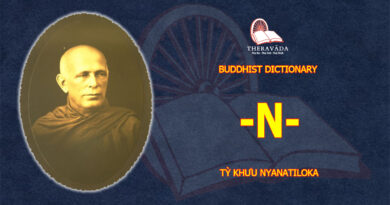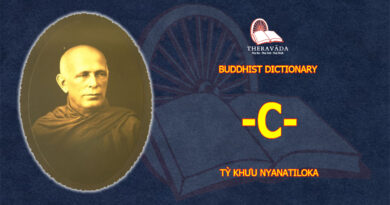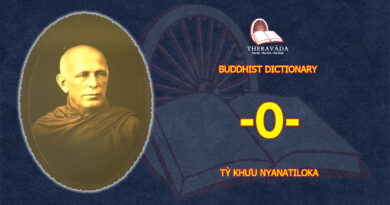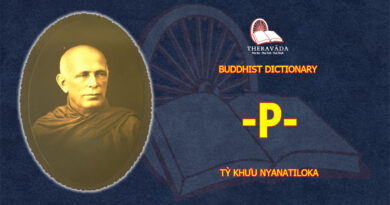BUDDHIST DICTIONARY
-L-
lahutā: ‘lightness’, or ‘agility’, may be of 3 kinds: of corporeality (rūpassa lahutā; s. khandha, I ), of mental factors (kāya-lahutā), and of consciousness (citta-lahutā). Cf. Tab. II.
lakkhaṇa: ‘characteristics’. For the 3 ch. of existence, s. ti-lakkhaṇa.
law: dhamma (q.v.).
learning, wisdom based on: s. paññā.
liberality: dāna (q.v.), cāga (q.v.).
liberation: s. vimokkha.
life-infatuation: s. mada.
light, perception of: s. āloka-saññā.
light-kasiṇa: s. kasiṇa.
lightness (of corporeality, mental factors and consciousness): lahutā (q.v.).
loathsomeness (of the body): s. asubha, sīvathikā, kāyagatāsati.
lobha: ‘greed’, is one of the 3 unwholesome roots (mūla, q.v.) and a synonym of rāga (q.v.) and taṇhā (q.v.).
lobha-carita: ‘greedy-natured’, s. carita.
lofty consciousness: s. Sobhana.
lohita-kasiṇa: ‘red-kasiṇa’, s. kasiṇa.
loka: ‘world’, denotes the 3 spheres of existence comprising the whole universe, i.e. (1) the sensuous world (kāma-loka), or the world of the 5 senses; (2) the fine-material world (rūpa-loka), corresponding to the 4 fine-material absorptions (s. jhāna 1-4); (3) the immaterial world (arūpa-loka), corresponding to the 4 immaterial absorptions (s. jhāna, 5-8).
The sensuous world comprises the hells (niraya ), the animal kingdom (tiracchāna-yoni), the ghost-realm (peta-loka), the demon world (asura-nikāya), the human world (manussa-loka) and the 6 lower celestial worlds (s. deva I). In the fine-material world (s. deva II) still exist the faculties of seeing and hearing, which, together with the other sense faculties, are temporarily suspended in the 4 absorptions. In the immaterial world (s. deva III) there is no corporeality whatsoever, only the four mental groups (s. khandha) exist there.
Though the term loka is not applied in the Suttas to those 3 worlds, but only the term bhava, ‘existence’ (e.g. M. 43), there is no doubt that the teaching about the 3 worlds belongs to the earliest, i.e. Sutta-period, of the Buddhist scriptures, as many relevant passages show.
loka-dhamma: ‘worldly conditions’. “Eight things are called worldly conditions, since they arise in connection with worldly life, namely: gain and loss, honour and dishonour, happiness and misery, praise and blame” (Vis.M. XXII). Cf. also A. VIII, 5.
lokiya: ‘mundane’, are all those states of consciousness and mental factors – arising in the worldling, as well as in the Noble One – which are not associated with the supermundane (lokuttara; s. the foll.) paths and fruitions of Sotāpatti, etc. See ariyapuggala, A.
lokuttara: ‘supermundane’, is a term for the 4 paths and 4 fruitions of Sotāpatti, etc. (s. ariya-puggala), with Nibbāna as ninth. Hence one speaks of ‘9 supermundane things’ (nava-lokuttara dhamma). Cf. prec.
loving-kindness: mettā; s. brahmavihāra.
lower fetters, the 5: s. saṃyojana.
lower worlds, the 4: apāya (q.v.).
low speech: tiracchāna-kathā (q.v.).
lust: s. rāga.

